We provide a three-year warranty for the poor performance of battery products when used correctly in accordance with the product manual instructions.. The warranty is in effect from the date of purchase by the user. Please read the product manual carefully before installing and using the product and use the battery correctly under the manual's instructions.
LiFePO4 Lithium Battery
1. Are Easunpower LiFePO4 Lithium batteries safe?
Yes. LiFePO4 is an inherently safe chemistry and the most stable lithium-type battery on the market.
Easunpower lithium cells are UL-certified for the highest safety and sustainability standards. All Easunpower LiFePO4 batteries come with an internal Battery Management System, which protects against under-voltage during discharge, over-voltage during charge, over-current during discharge, over-temperature during charge and discharge, and short-circuit protection – protects battery cells from damage. Additionally, Easunpower LiFePO4 Lithium batteries have been tested to be free from the risk of fire, and electric shock in harsh environments.
2. Easunpower LiFePO4 Lithium batteries as starting batteries?
No. Easunpower LiFePO4 lithium batteries are not intended to be used as starting batteries but energy storage, please do not use them to start any devices.
3. Can I charge Easunpower LiFePO4 lithium batteries in cold weather (under freezing temperatures)?
The Easunpower 12V 100Ah LiFePO4 batteries can be safely charged between 32°F to 113°F (0°C to 45°C). But when charging under the freezing point, the battery cells may be damaged.
4. How do I store Easunpower LiFePO4 lithium batteries?
It is recommended to store Easunpower LiFePO4 batteries at 50% state of charge (SOC). If the batteries are stored for long periods, cycle the batteries at least every 6 months. Recommended storage environment: 10℃~35℃ (50℉~95℉), 45%RH~75%RH.
5. How long to charge Easunpower LiFePO4 lithium batteries?
You can charge our Easunpower 12V 100Ah lithium battery with a 12V 10Ah or 12V 20Ah charger, and a full charge will take 10 hours and 5 hours respectively.
6. Can I charge Easunpower LiFePO4 Lithium batteries with solar panels?
Yes, you can charge Easunpower LiFePO4 lithium batteries with solar panels. There are 3 ways to charge.
1. Using Solar Panels
The battery can be fully charged in one day (with effective sunshine 4.5 hrs/day) by 300W solar panels. It may take more than one day to fully charge the battery by ≥300W solar panels since the duration and intensity of light would be a great factor for their charging efficiency.
Besides solar panels, there are 2 more ways to charge.
2. Generator/Alternator
If the alternator or generator supports DC output, a DC-to-DC charger is needed to connect the battery to the generator; if your alternator or generator supports AC output, please add a suitable battery charger to connect the battery and the generator according to our recommendations. The Recommended Charging Voltage: 14.2V - 14.6V. The Recommended Charging Current: ① 20A (0.2C): the battery will be fully charged in around 5 hrs to 100% capacity; ② 50A (0.5C): the battery will be fully charged in around 2 hrs to around 97% capacity.
3. LiFePO4 Smart Chargers
To charge 12V battery, it is recommended to use 14.6V battery charger.
The Recommended Charging Voltage: 14.2V - 14.6V.
The Recommended Charging Current: ① 20A (0.2C): the battery will be fully charged in around 5 hrs to 100% capacity; ② 50A (0.5C): the battery will be fully charged in around 2 hrs to around 97% capacity.
7. What to do when receive the battery?
Upon receiving your battery, please note that it may arrive with a low State of Charge (SOC) as a result of the transportation and storage process. To ensure peak performance, we advise promptly charging the battery to prevent over-discharge.
If you intend to store the battery for an extended period without use, we recommend charging it to a SOC 50% and conducting maintenance every three months. These measures will help preserve its functionality and performance in the long run.
8. What are the Differences Between a Group 24 and Group 31 Battery?
The main difference between a Group 24 and Group 31 battery lies in their physical size. Group 24 batteries are generally smaller compared to Group 31 batteries.
Can read on Deep Cycle Group 24 VS Group 31 for more information.
9. Can I connect Easunpower lithium battery in series or paralle?
To connect in series or parallel, batteries should meet the below conditions:
- identical batteries with the same battery capacity (Ah) and BMS (A);
- from the same brand (as lithium battery from different brands has their special BMS);
- purchased in near time (within one month).
10. How many batteries can I connect in sereis or parallel?
The maximum number of connecting Easunpower 12V 100Ah lithium batteries in series or parallel is 4 (4S or 4P). Please notice that the Easunpower lithium batteries can ONLY be connected in series or parallel with the same brand (Easunpower), same type (lithium), same voltage (V), same capacity (Ah), same BMS and similar purchasing date (within 3-6 months).








